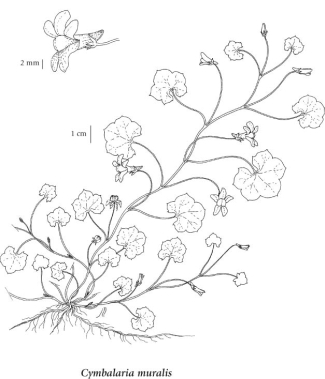Cymbalaria muralis G. Gaertn., B. Mey. & Scherb.
ivy-leaved toadflax (Kenilworth ivy)
Plantaginaceae (Mare's-tail family)
(Previously in Scrophulariaceae)
Introduction to Vascular Plants
ivy-leaved toadflax (Kenilworth ivy)
Plantaginaceae (Mare's-tail family)
(Previously in Scrophulariaceae)
Introduction to Vascular Plants
Introduction
This is a tiny trailing vine that originates in the Mediterranean area. It is reported to have colonized Britain in 1640 (Farmer 2010). It is now found widely in North America (US: AR, CA, CO, CT, DE, HI, IL, IN, KY, MA, MD, MI, MO, NC, NE, NJ, NY, OH, OR, PA, SC, SD, TN, UT, VA, VT, WA, WI, WV--CAN: BC, MB, NB, NS, ON, QC) (USDA 2010). In BC, it flowers in the spring (April/May) in disturbed sites in the southwestern corner of the province (southeastern Vancouver Island, the Gulf Islands, and the Lower Mainland).
|
Species Information
General:
Annual, biennial, or short-lived perennial herb; stems trailing or climbing, 10-80 cm long, rooting at the nodes, smooth, often purplish.
Leaves:
Alternate, long-stalked, ivy-like, about 2.5 cm long, more or less round in outline but palmately and shallowly 3- to 7-lobed, smooth, sometimes purplish beneath, the stalks longer than the blades.
Flowers:
Inflorescence of single long-stalked flowers in the axils of leaves, the stalks about 2 cm long; corollas lilac to violet with a yellow patch at the throat, 8-10 mm long, distinctly spurred at the base, the spur curved, 2-3 mm long and blunt-tipped, 2-lipped, the upper lip with 2 erect lobes, the lower lip with 3 spreading lobes; calyces deeply 5-lobed, the lobes linear-lanceolate, about 1/2 as long as the corolla tube; stamens 4.
Fruits:
Capsules, globe-shaped, 3-4 mm in diameter, opening by 2 lateral pores; seeds egg-shaped, with thick wavy ridges.
Illustration

If more than one illustration is available for a species (e.g., separate illustrations were provided for two subspecies) then links to the separate images will be provided below. Note that individual subspecies or varietal illustrations are not always available.
Illustration Source: The Illustrated Flora of British Columbia
Habitat and Range
Mesic to dry waste places and rocky banks in the lowland zone; infrequent in the Gulf Islands and adjacent lower mainland; introduced from Eurasia.Synonyms
Synonyms and Alternate Names:
Linaria cymbalaria (L.) Mill.